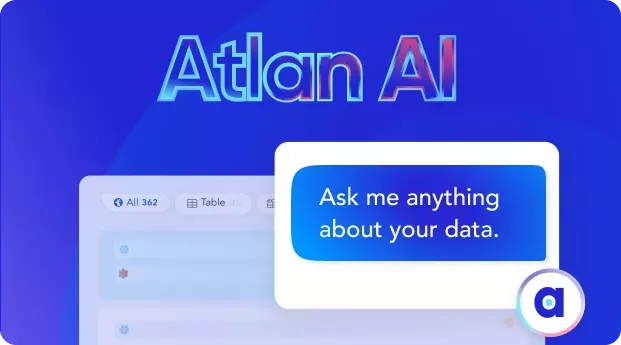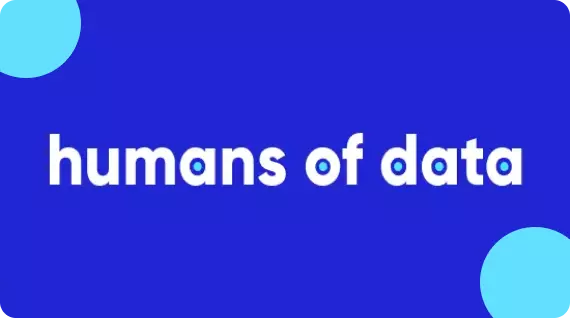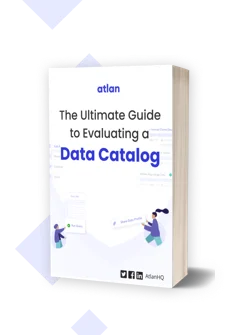Modern Data Platform: Key Components, Capabilities & Tools
Share this article
A modern data platform integrates tools and technologies to manage, process, and analyze large volumes of data efficiently. Key features include cloud storage, scalability, and compatibility with various data sources to support both structured and unstructured data. It often employs real-time processing, advanced analytics, and machine learning to derive actionable insights.
See How Atlan Streamlines Metadata Management – Start Tour
Data platforms are composed of technology units that collect, transform, analyze and deliver data. While data platforms are nothing new, they’re being constantly redefined. In fact, a key distinguishing feature of data platforms is expandability — the ability to grow with advances in technology. Still, there are constants that never change.
In this blog, we’ll define and explore the characteristics of the modern data platform as seen in its latest evolution.
Table of contents #
- What is a modern data platform?
- The three characteristics of a modern data platform
- The building blocks of a modern data platform
- Metadata Management: the control plane of the modern data platform
- FAQs about Modern Data Platform
- Modern data platform: Related reads
What is a modern data platform? #
A modern data platform is designed to be democratic, proactive, scalable, and flexible to respond to future technologies and evolving needs of modern data teams. It is the technological base on which data tools and applications connect or sit. Think of it as the operating system of the data stack. It provides the acquisition, storage, preparation, and analysis functions necessary so that users can make data-inspired decisions.
Just as most home computers run on one of two operating systems (Windows or Mac OS), there are only a handful of players in the cloud data platform space (AWS, Azure, Google Cloud, IBM, Oracle). The data platform hypothesis posits that consolidation around these cloud-based vendors has led to data being collected in a standard set of systems, This is beneficial for developers who can use this single point of integration to build new applications. These include dashboards or data catalogs, along with tools for orchestration, governance, and observability – all of which connect to data platforms and form the modern data stack.
The three characteristics of a modern data platform #
There are really three characteristics that set the modern data platform apart from older generations:
- Self-service for diverse users
- Agile data management
- Flexible, fast, pay as you go
Self-service for diverse users #
Previously, data was siloedand accessible for the exclusive use of data professionals. A modern data platform removes barriers so that everyone within an organization is able to access and leverage data.
Data democratization requires technology that is intuitive to use and features easy discovery capabilities so that users can find what they need as easily as using Google. Users should also be able to perform basic analysis, understand the context of the data, and derive insights all on their own.
Agile data management #
Modern data platforms are governed by the twin principles of availability and elasticity:
- Availability refers to data being readily available in a data lake or warehouse that separates storage and compute. Splitting the two functions enables the cheap storage of large amounts of data.
- Elasticity refers to cloud-based compute functions that scale automatically to meet demand. For example, if the data team runs a lot of analysis on Monday, then processing power will expand on that day to meet the need, before contracting to save on power.
Flexible, fast, pay as you go #
As previously mentioned, modern data platforms are mostly run on cloud infrastructures. Today’s cloud solutions are easy to set up, fast (by leveraging data lakes or lakehouses which reduce ETL time), and flexible so they evolve with future technologies. Plus, you don’t have to invest in building a massive on-premise infrastructure, instead, paying for only what you need.
The building blocks of a modern data platform #
The foundation of any modern data platform is constructed using the same building blocks which include:
- Sources
- Ingestion and transport
- Storage
- Query and processing
- Transformation
- Analysis and output
Sources #
These are where data originates. OLTP databases, logs, 3rd party APIs, file and object storage, event collectors, apps, etc. can all be sources of data.
Ingestion and transport #
After data is generated at a source, it’s moved (typically in real-time or in batches) to a destination for storage, query, and analysis. In a modern data platform, this process of ingestion and transport is usually performed automatically rather than manually, which was the case with traditional data platforms.
Ingestion and transport tools include Fivetran, Hevo Data, Stitch, Pulsar, and Upsolver.
Storage #
Data is commonly stored in data warehouses, and, increasingly, in data lakes or data lakehouses which allow for the fast migration of data from a source to storage. That’s because data lakes and lakehouses are able to house raw, unstructured data, delaying the time-consuming transformation process until it’s needed for analysis.
Storage tools include Amazon S3, Azure Data Lake Storage Gen2, Google Cloud Storage, Redshift, and Snowflake.
Query and processing #
Data warehouses and data lakehouses allow for query and processing where users can perform simple or complex searches. The data can also be processed, that is to say, validated, sorted, summarized, and aggregated. Query and processing can also occur via Spark, a SQL query engine, or a data science/machine learning platform.
Query and processing tools include Databricks, Pandas, Dask, Confluent, and Flink.
Transformation #
Previously, ETL was performed locally onsite and was slow due to limited computing power. A modern data platform utilizes the latest transformation technique – cloud ETL, which leverages the power and performance of a cloud environment to execute faster data transformations, reducing time to insights. The ability to transform data in hours, rather than days, enables data to be used in predictive machine learning and artificial intelligence models (which require lots of data), driving even more valuable business intelligence.
Transformation tools include AWS Glue, dbt, Matallion, and Domo.
Analysis and output #
A modern data platform provides a workspace for users to derive analysis and insights. This business intelligence can then be presented with visualizations (e.g., charts and graphs) so that it’s intelligible to all, not just those with a data background.
Analysis and output tools include Looker, Mode, and Tableau.
Metadata Management: the control plane of the modern data platform #
The modern data platform is a powerful technology that is fast, simple to set up, and easy to scale - all without a significant capital investment. Still, it falls short in bringing discovery, trust, and context to data. The data is often isolated in data silos making it difficult to find, leverage, or even know what actually exists. As a result, data workers spend the majority of their time searching for and preparing data, rather than analyzing it for insights. But that’s where metadata comes in.
Metadata management has become the control plane of the modern data platform. It’s an indispensable practice in bringing context to data by providing attributes like data source, origin, owner, query logs, lineage, and quality score.
Atlan is a modern data workspace that leverages active metadata for better data discovery, lineage, cataloging, and governance. Our metadata management solution helps teams better locate, manage, organize, and understand data assets.
It features AI-powered capabilities to enhance user experiences, offers personalized experiences for diverse personas, and allows for programmatic access through APIs. Its platform-agnostic approach ensures seamless integration with existing data ecosystems.
Book your personalized demo today to find out how Atlan can help your organization in establishing and scaling data governance programs as a modern data platform.
FAQs about Modern Data Platform #
What is a modern data platform? #
A modern data platform is a cloud-based system comprising various tools designed to manage data effectively. It facilitates cost-effective data management, offers fast insights, ensures robust governance, and promotes data democratization.
What are the key characteristics of a modern data platform? #
The three defining characteristics of a modern data platform are:
- Self-service: Enables a range of users, from analysts to business leaders, to access and utilize data independently.
- Agile data management: Adapts quickly to changing data needs and scales accordingly.
- Flexible and cost-efficient: Operates on a “pay as you go” model, offering flexibility and cost control.
What are the building blocks of a modern data platform? #
The essential components include:
- Data Sources: The origin points where data is generated.
- Ingestion and Transport: Processes for collecting and moving data.
- Storage: Storing data in a scalable and accessible manner.
- Query and Processing: Tools and systems for analyzing data.
- Transformation: Converting raw data into a structured format.
- Analysis and Output: Creating insights and delivering them to end-users.
- Metadata Management: Acts as the control plane, ensuring governance and data quality.
Modern data platform: Related reads #
- Modern data teams: Roles, structure and how do you build one
- Modern data catalogs: 5 essential features and evaluation guide
- What is a data lake? Definition, architecture, and solutions
- Modern data culture: The open secret to great data teams
- What is modern data stack: History, components, platforms, and the future
- What is data democratization: Definition, benefits, and strategy
- Data Catalog: What It Is & How It Drives Business Value
- What Is a Metadata Catalog? - Basics & Use Cases
- Modern Data Catalog: What They Are, How They’ve Changed, Where They’re Going
- Open Source Data Catalog - List of 6 Popular Tools to Consider in 2024
- 5 Main Benefits of Data Catalog & Why Do You Need It?
- Enterprise Data Catalogs: Attributes, Capabilities, Use Cases & Business Value
- The Top 11 Data Catalog Use Cases with Examples
- 15 Essential Features of Data Catalogs To Look For in 2024
- Data Catalog vs. Data Warehouse: Differences, and How They Work Together?
- Snowflake Data Catalog: Importance, Benefits, Native Capabilities & Evaluation Guide
- Data Catalog vs. Data Lineage: Differences, Use Cases, and Evolution of Available Solutions
- Data Catalogs in 2024: Features, Business Value, Use Cases
- AI Data Catalog: Exploring the Possibilities That Artificial Intelligence Brings to Your Metadata Applications & Data Interactions
- Amundsen Data Catalog: Understanding Architecture, Features, Ways to Install & More
- Machine Learning Data Catalog: Evolution, Benefits, Business Impacts and Use Cases in 2024
- 7 Data Catalog Capabilities That Can Unlock Business Value for Modern Enterprises
- Data Catalog Architecture: Insights into Key Components, Integrations, and Open Source Examples
- Data Catalog Market: Current State and Top Trends in 2024
- Build vs. Buy Data Catalog: What Should Factor Into Your Decision Making?
- How to Set Up a Data Catalog for Snowflake? (2024 Guide)
- Data Catalog Pricing: Understanding What You’re Paying For
- Data Catalog Comparison: 6 Fundamental Factors to Consider
- Alation Data Catalog: Is it Right for Your Modern Business Needs?
- Collibra Data Catalog: Is It a Viable Option for Businesses Navigating the Evolving Data Landscape?
- Informatica Data Catalog Pricing: Estimate the Total Cost of Ownership
- Informatica Data Catalog Alternatives? 6 Reasons Why Top Data Teams Prefer Atlan
- Data Catalog Implementation Plan: 10 Steps to Follow, Common Roadblocks & Solutions
- Data Catalog Demo 101: What to Expect, Questions to Ask, and More
- Data Mesh Catalog: Manage Federated Domains, Curate Data Products, and Unlock Your Data Mesh
- Best Data Catalog: How to Find a Tool That Grows With Your Business
- How to Build a Data Catalog: An 8-Step Guide to Get You Started
- The Forrester Wave™: Enterprise Data Catalogs, Q3 2024 | Available Now
- How to Pick the Best Enterprise Data Catalog? Experts Recommend These 11 Key Criteria for Your Evaluation Checklist
- Collibra Pricing: Will It Deliver a Return on Investment?
- Data Lineage Tools: Critical Features, Use Cases & Innovations
- OpenMetadata vs. DataHub: Compare Architecture, Capabilities, Integrations & More
- Automated Data Catalog: What Is It and How Does It Simplify Metadata Management, Data Lineage, Governance, and More
- Data Mesh Setup and Implementation - An Ultimate Guide
- What is Active Metadata? Your 101 Guide
Photo by Mo
Share this article










